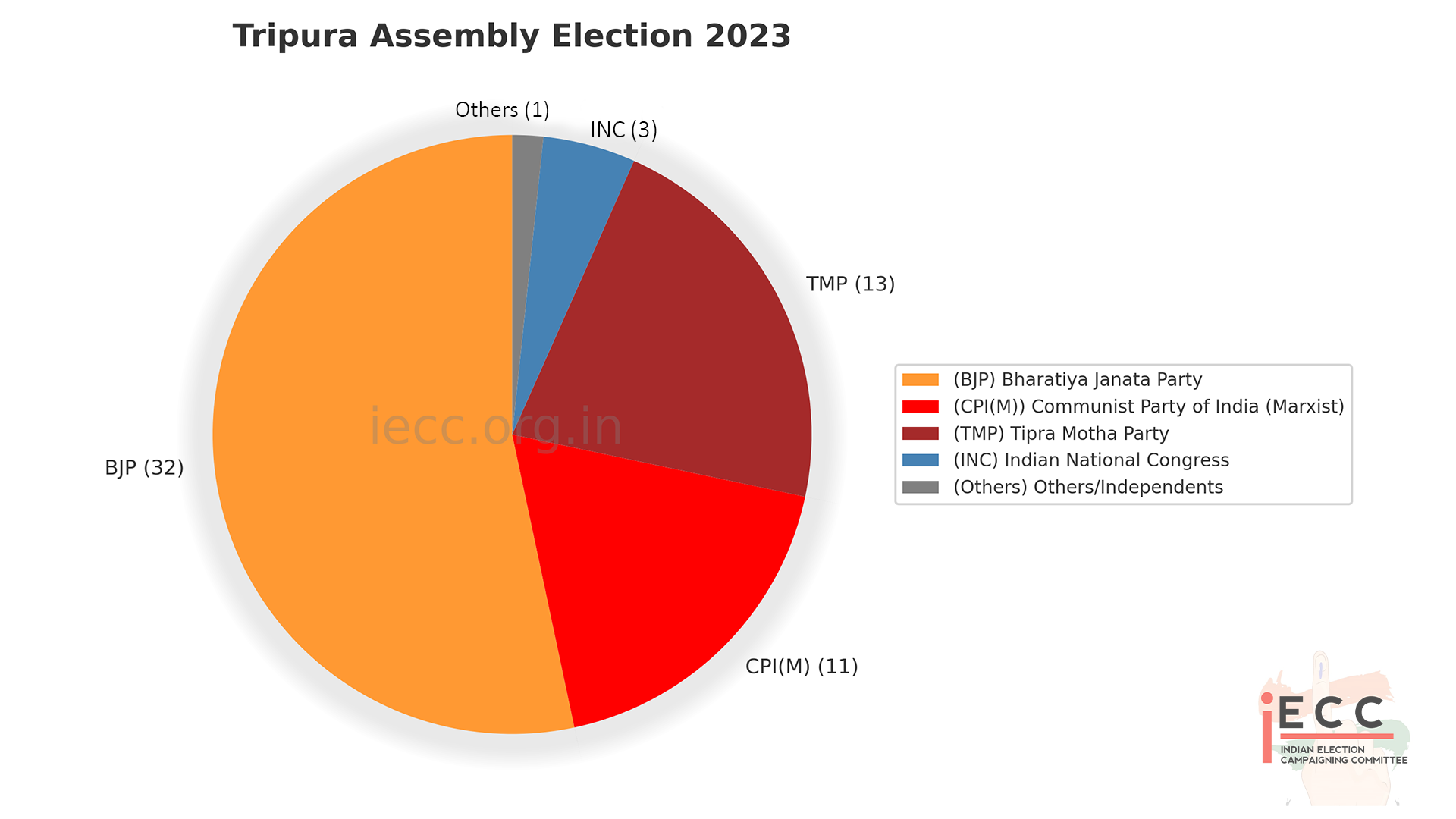Tripura Assembly Election
1967 Tripura Legislative Assembly Election Results
| 1967 Tripura Assembly Election Results | |||
|---|---|---|---|
| Sr. No. | Short Name | Full Name | Seats |
| 1 | INC | Indian National Congress | 27 |
| Total | 27 | ||
The Indian National Congress (INC) swept the election, winning 27 out of 30 seats.
Congress leader Sachindra Lal Singh became the first Chief Minister of Tripura.
The Communist Party of India (CPI) and independents had almost no significant role in the assembly.
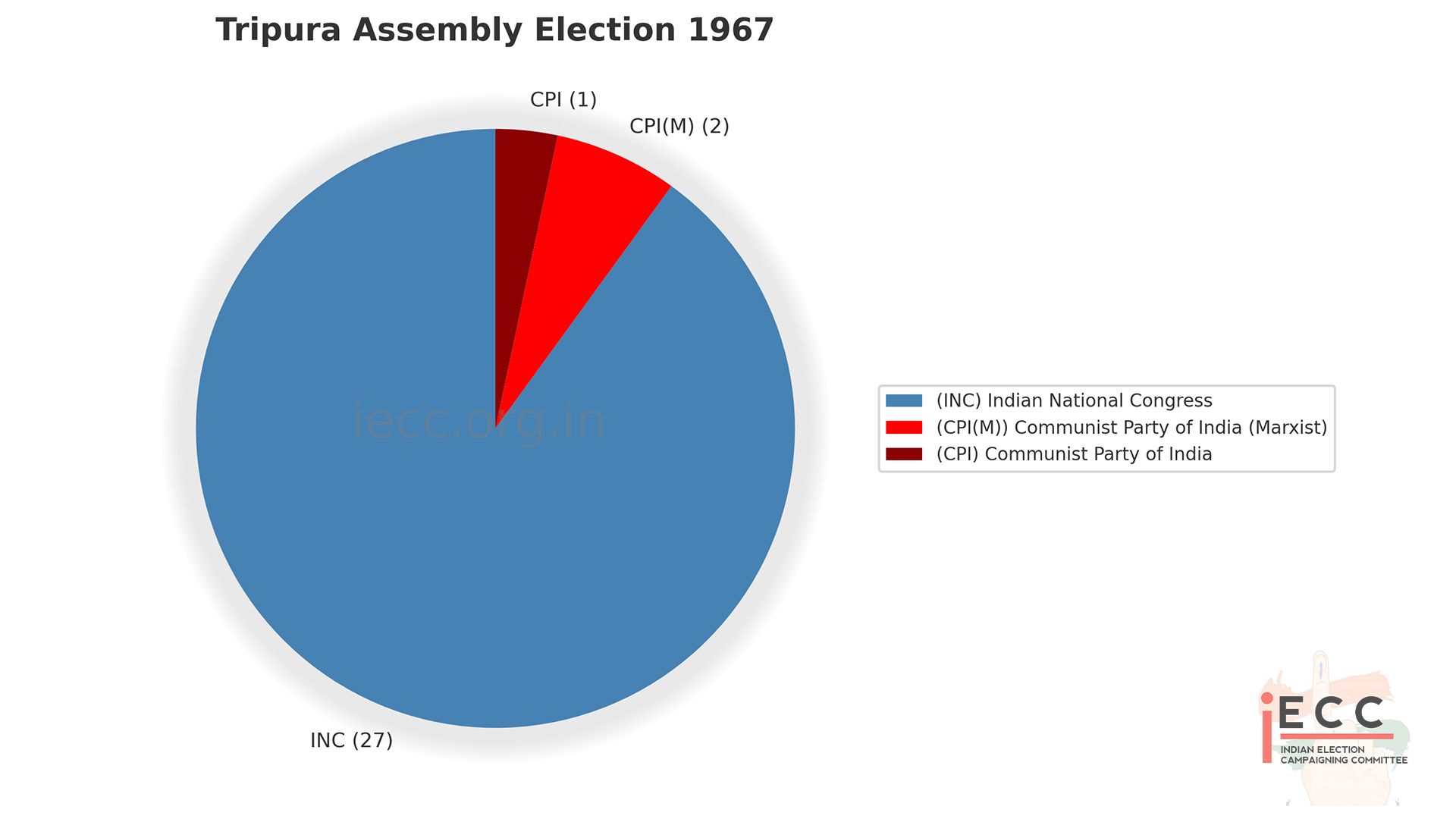
1972 Tripura Legislative Assembly Election Results
| 1972 Tripura Legislative Assembly Election Results | |||
|---|---|---|---|
| Sr. No. | Short Name | Full Name | Seats |
| 1 | INC | Indian National Congress | 41 |
| 2 | CPI(M) | Communist Party of India (Marxist) | 16 |
| 3 | Independents & Others | Independents & Others | 3 |
| Total | 60 | ||
The Indian National Congress (INC) won 41 seats, easily crossing the majority mark of 31. Sukhamoy Sen Gupta became Chief Minister.
The CPI(M) emerged strongly with 20 seats, becoming the main opposition party and showing the growing strength of Left politics in Tripura.
This election marked the beginning of a two-party rivalry between Congress and the Left, which went on to dominate Tripura’s politics for decades.
While Congress secured victory in 1972, the Left parties kept expanding their base, especially among peasants and tribal communities, laying the foundation for future wins.

1977 Tripura Legislative Assembly Election Results
| 1977 Tripura Legislative Assembly Election Results | |||
|---|---|---|---|
| Sr. No. | Short Name | Full Name | Seats |
| 1 | CPI(M) | Communist Party of India (Marxist) | 41 |
| 2 | Independents & Others | Independents & Others | 19 |
| Total | 60 | ||
The CPI(M)-led Left Front secured a clear majority with 41 seats, ending Congress dominance in Tripura.
Nripen Chakraborty, a veteran communist leader, became Chief Minister.
The Indian National Congress (INC) was reduced to 20 seats, marking its first major defeat in Tripura.
This election was part of a larger national trend in 1977, where Congress lost in many states due to anti-Emergency sentiments.
It was a historic shift—Tripura politics from here onward became dominated by the Left vs Congress rivalry, with the Left emerging as a major force.
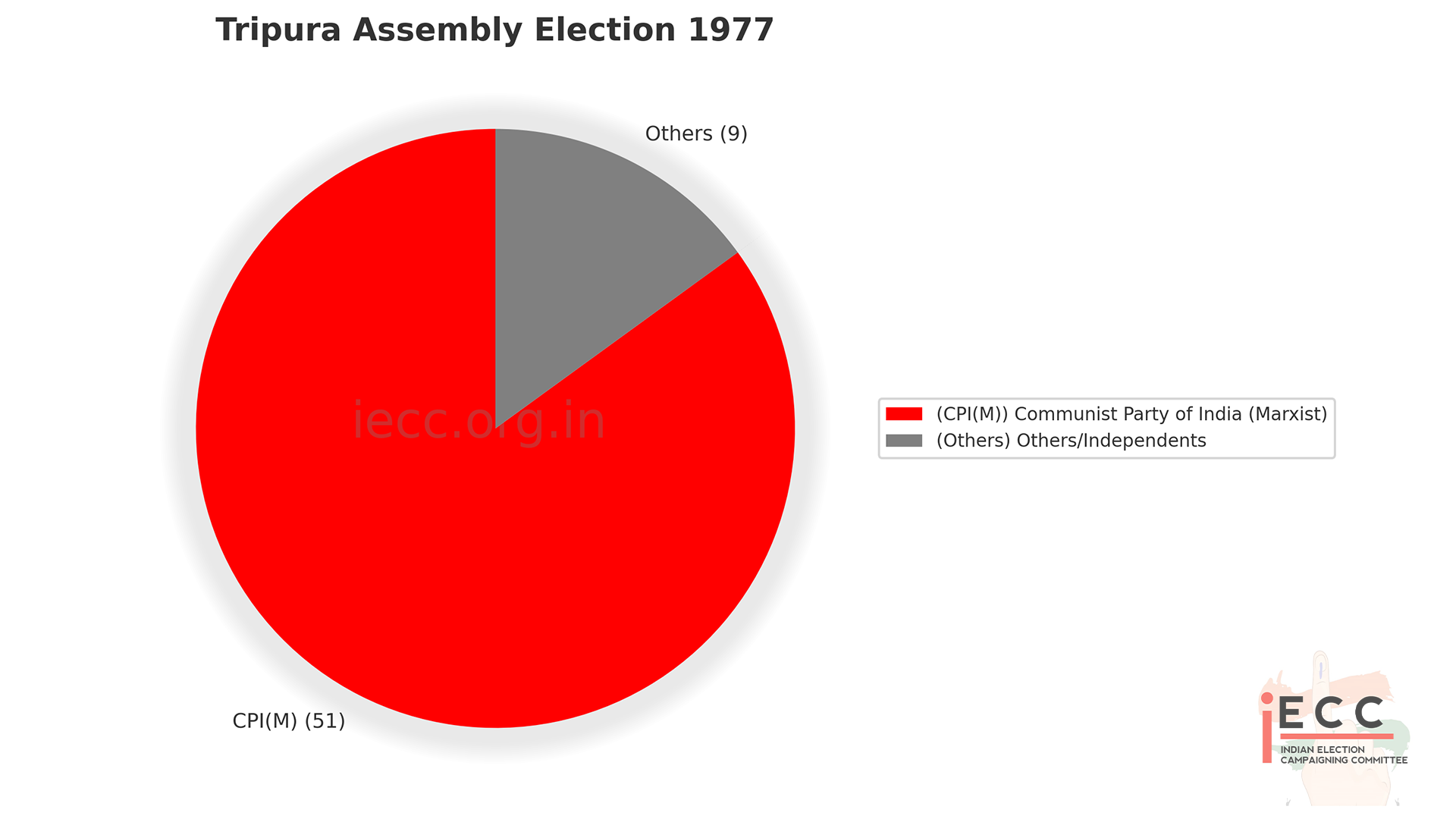
1983 Tripura Legislative Assembly Election Results
| 1983 Tripura Legislative Assembly Election Results | |||
|---|---|---|---|
| Sr. No. | Short Name | Full Name | Seats |
| 1 | CPI(M) | Communist Party of India (Marxist) | 39 |
| 2 | INC | Indian National Congress | 19 |
| 3 | Independents & Others | Independents & Others | 2 |
| Total | 60 | ||
The CPI(M)-led Left Front once again formed government with 39 seats, comfortably crossing the majority.
Nripen Chakraborty continued as Chief Minister, reinforcing Left dominance.
The Congress managed 19 seats, but its position as a ruling alternative weakened.
Independents/others won 2 seats, but they had no significant influence.
This election cemented the Left Front’s position in Tripura, which went on to dominate the state for decades (except brief interruptions).

1988 Tripura Assembly Election Results
| 1988 Tripura Assembly Election Result | |||
|---|---|---|---|
| Sr. No. | Short Name | Full Name | Seats |
| 1 | INC | Indian National Congress | 26 |
| 2 | CPI(M) | Communist Party of India (Marxist) | 26 |
| 3 | Independents & Others | Independents & Others | 8 |
| Total | 60 | ||
The Congress + TUJS alliance secured a majority (26 + 7 = 33 seats) and formed government.
Sudhir Ranjan Majumdar of the Congress became the Chief Minister.
The CPI(M) won 26 seats, a strong opposition but fell short of retaining power.
This election was significant as it was one of the very few times Congress managed to defeat the Left in Tripura.
However, internal conflicts and instability weakened the Congress-TUJS alliance, paving the way for the Left’s return in the next election (1993).
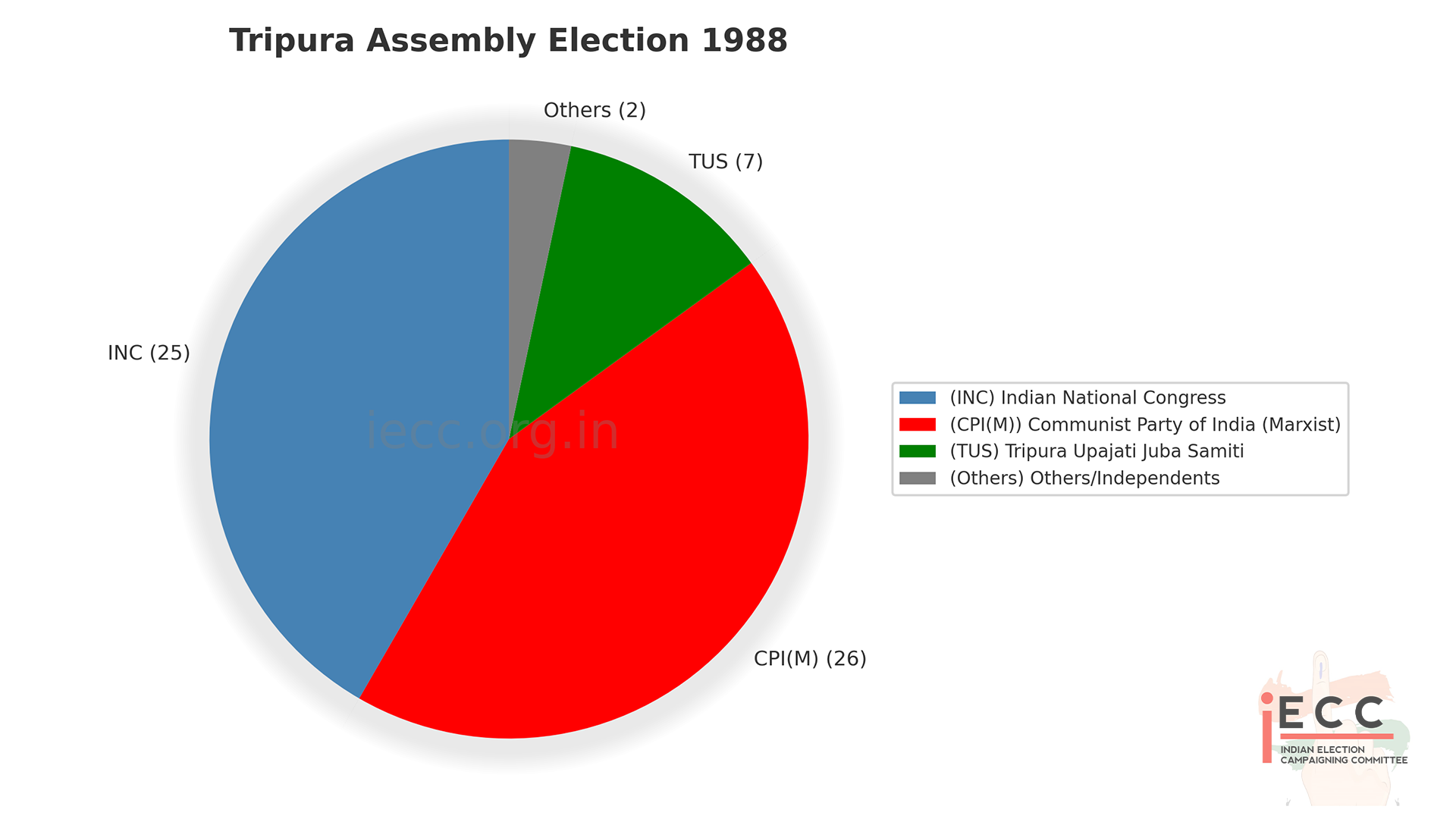
1993 Tripura Assembly Election Results
| 1993 Tripura Assembly Election Results | |||
|---|---|---|---|
| Sr. No. | Short Name | Full Name | Seats |
| 1 | CPI(M) | Communist Party of India (Marxist) | 44 |
| 2 | INC | Indian National Congress | 10 |
| 3 | Independents & Others | Independents & Others | 6 |
| Total | 60 | ||
The CPI(M)-led Left Front secured a landslide victory with 44 seats, easily crossing the majority mark.
Dasarath Deb, a senior CPI(M) leader, became Chief Minister.
The Congress collapsed to just 10 seats, reflecting dissatisfaction with its 1988–1993 rule.
TUJS, once a key ally of Congress, was reduced to 1 seat, showing the decline of regional tribal parties.
This election restored Left dominance in Tripura, which would continue almost uninterrupted for the next two decades.
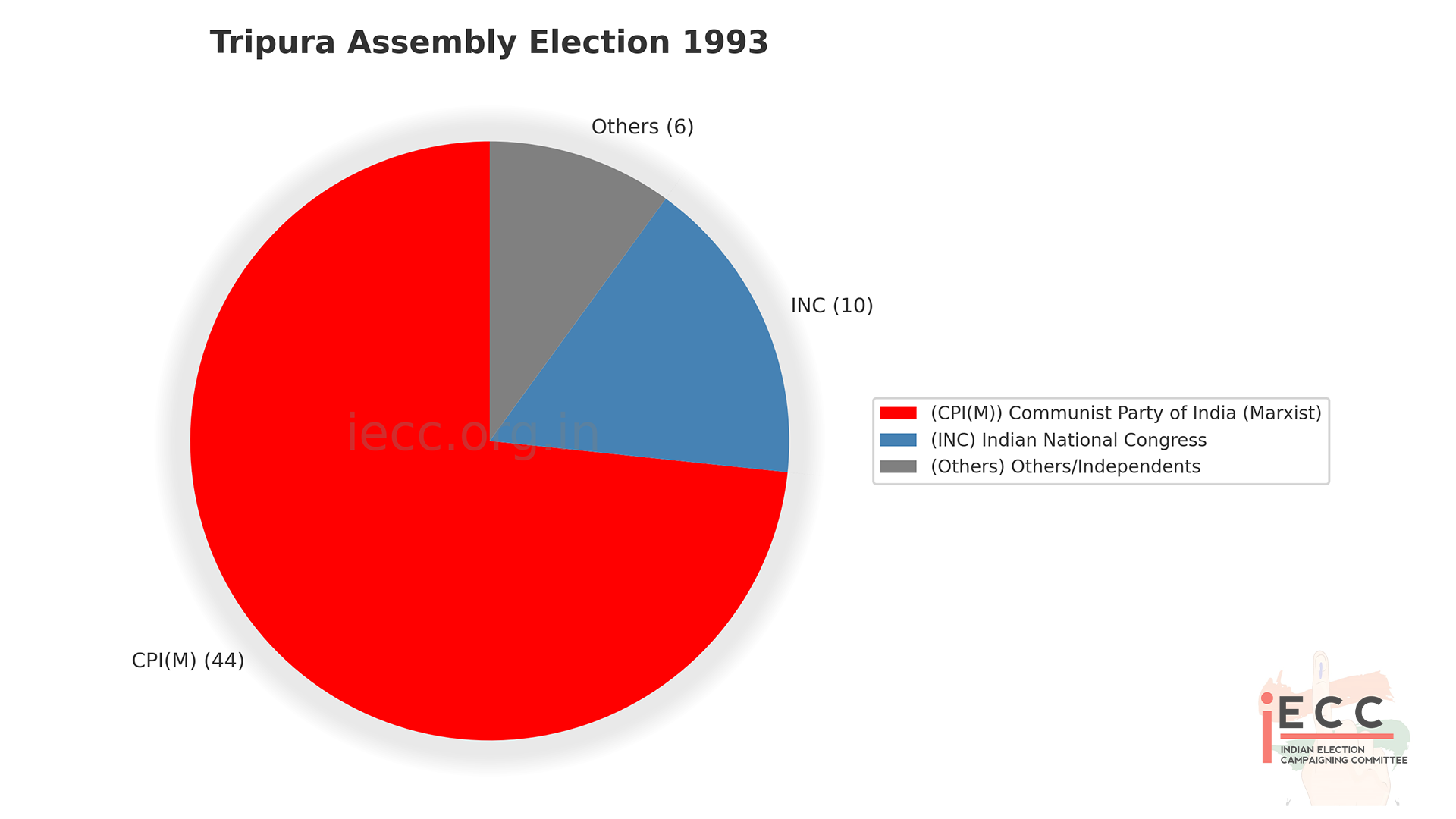
1998 Tripura Assembly Election Results
| 1998 Tripura Assembly Election Results | |||
|---|---|---|---|
| Sr. No. | Short Name | Full Name | Seats |
| 1 | CPI(M) | Communist Party of India (Marxist) | 38 |
| 2 | INC | Indian National Congress | 13 |
| 3 | Independents & Others | Independents & Others | 9 |
| Total | 60 | ||
The CPI(M)-led Left Front comfortably retained power with 38 seats.
Manik Sarkar became Chief Minister for the first time in 1998, succeeding Dasarath Deb.
The Congress secured 13 seats, unable to mount a strong challenge.
Smaller parties/Independents won 9 seats, but they had limited influence.
This election marked the start of a long, stable Left rule under Manik Sarkar, who became one of India’s longest-serving Chief Ministers.
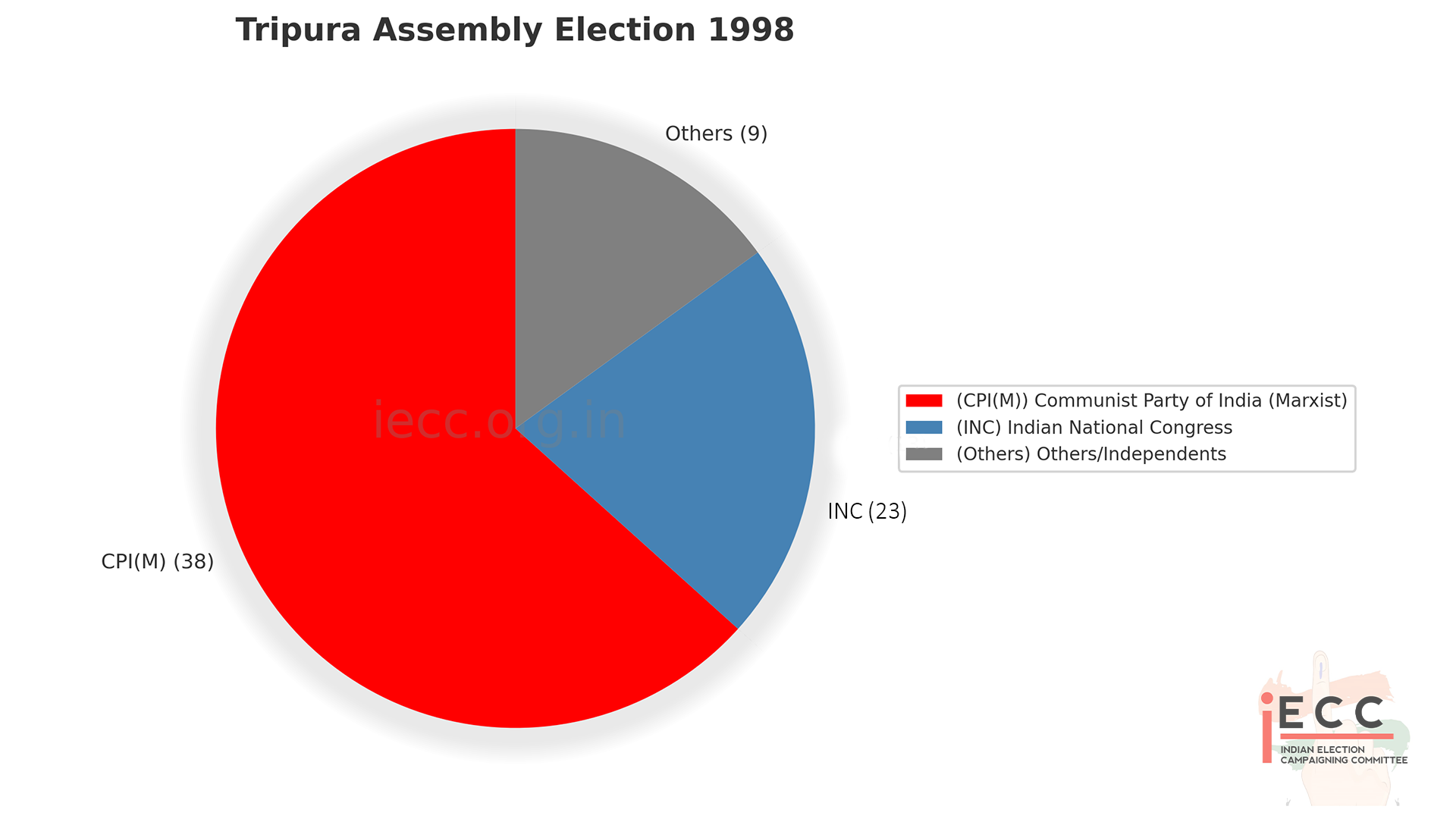
2003 Tripura Assembly Election Results
| 2003 Tripura Assembly Election Results | |||
|---|---|---|---|
| Sr. No. | Short Name | Full Name | Seats |
| 1 | CPI(M) | Communist Party of India (Marxist) | 38 |
| 2 | INC | Indian National Congress | 13 |
| 3 | Independents & Others | Independents & Others | 9 |
| Total | 60 | ||
The CPI(M)-led Left Front again won 38 seats, ensuring Manik Sarkar’s second consecutive term as CM.
The Congress stagnated at 13 seats, unable to challenge the Left.
The Indigenous Nationalist Party of Twipra (INPT), a tribal-based party, entered the scene with 6 seats, showing the growing importance of tribal politics in Tripura.
Independents and smaller parties won 3 seats.
This election proved that Manik Sarkar’s leadership and Left governance model had strong voter support.

2008 Tripura Assembly Election Results
| 2008 Tripura Assembly Election Results | |||
|---|---|---|---|
| Sr. No. | Short Name | Full Name | Seats |
| 1 | CPI(M) | Communist Party of India (Marxist) | 46 |
| 2 | INC | Indian National Congress | 10 |
| 3 | Independents & Others | Independents & Others | 4 |
| Total | 60 | ||
The CPI(M) achieved a landslide win with 46 seats, one of the strongest mandates in Tripura’s history.
Manik Sarkar was sworn in as Chief Minister for the third consecutive term.
The Congress managed only 10 seats, continuing to struggle against the Left.
The INPT, once a growing tribal party, was reduced to just 1 seat, showing the CPI(M)’s deep reach even in tribal regions.
Independents/others won 3 seats but remained irrelevant in government formation.
This victory made Tripura a stronghold of the CPI(M), with Manik Sarkar becoming one of the most popular Left leaders in India.

2013 Tripura Assembly Election Results
| 2013 Tripura Assembly Election Results | |||
|---|---|---|---|
| Sr. No. | Short Name | Full Name | Seats |
| 1 | CPI(M) | Communist Party of India (Marxist) | 49 |
| 2 | INC | Indian National Congress | 10 |
| 3 | Independents & Others | Independents & Others | 1 |
| Total | 60 | ||
The CPI(M) registered a thumping win with 49 seats, its best-ever performance.
Manik Sarkar became Chief Minister for the fourth straight time, continuing his rule from 1998.
The Congress remained stuck at 10 seats, unable to mount a challenge.
The INPT (a tribal party) lost all representation in the Assembly, marking its downfall.
Independents managed just 1 seat.
The Left Front’s dominance peaked in 2013, with CPI(M) controlling over 80% of the Assembly seats.

2018 Tripura Assembly Election Results
| 2018 Tripura Assembly Election Results | |||
|---|---|---|---|
| Sr. No. | Short Name | Full Name | Seats |
| 1 | BJP | Bharatiya Janata Party | 36 |
| 2 | IPFT | Indigenous People’s Front of Tripura | 8 |
| 3 | Independents & Others | Independents & Others | 16 |
| Total | 60 | ||
The BJP, which had almost no presence in Tripura earlier, won a historic 36 seats, forming the government for the first time.
Its ally, the Indigenous People’s Front of Tripura (IPFT), a tribal party, won 8 seats.
Together, the BJP+IPFT alliance secured 44 seats, a clear majority.
The CPI(M), which ruled Tripura for 25 years straight, collapsed to just 16 seats.
The Congress was completely wiped out, winning 0 seats.
Biplab Kumar Deb (BJP) became Chief Minister, marking the end of Manik Sarkar’s long tenure (1998–2018).
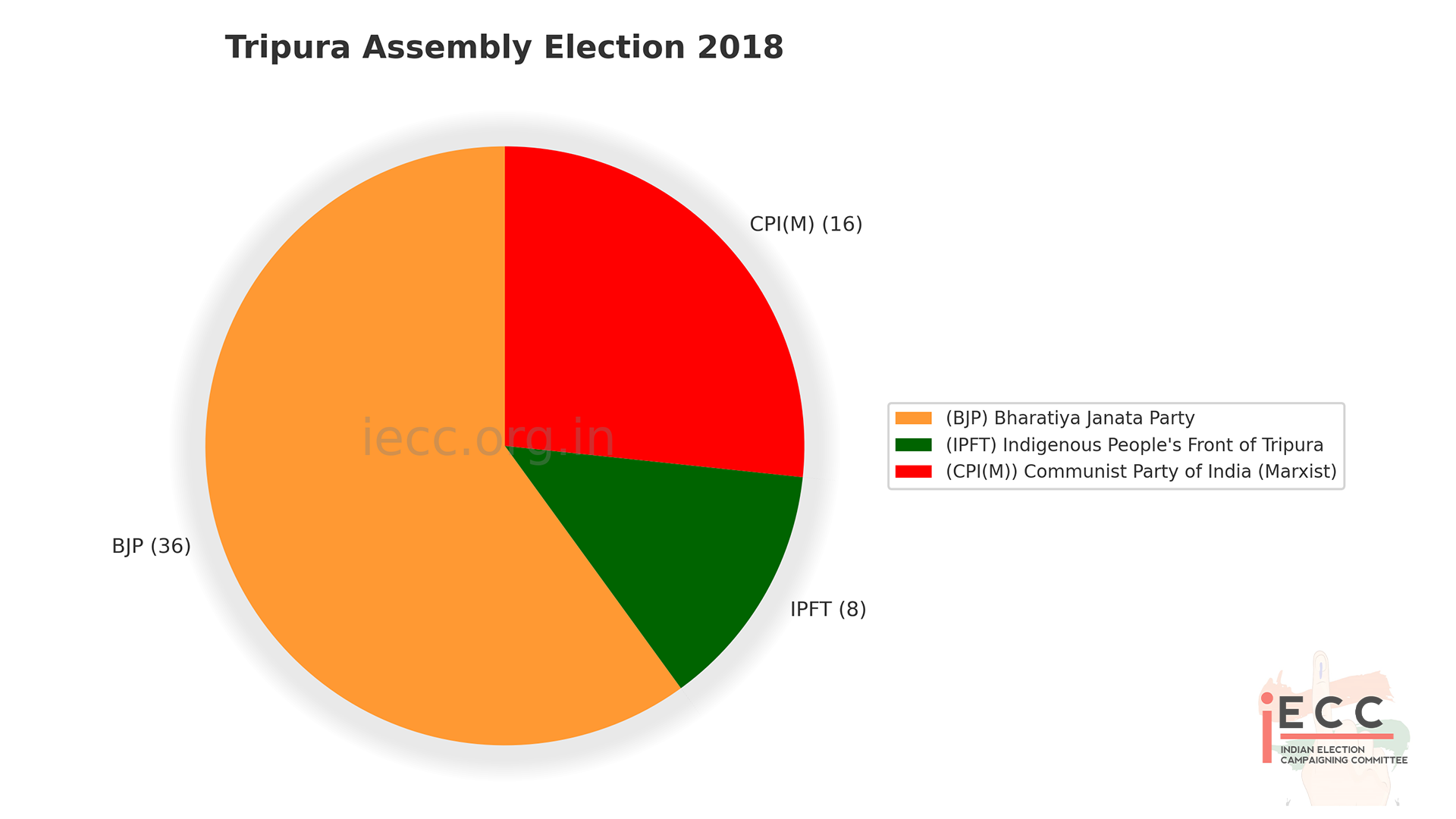
2023 Tripura Assembly Election Results
| 2023 Tripura Assembly Election Results | |||
|---|---|---|---|
| Sr. No. | Short Name | Full Name | Seats |
| 1 | BJP | Bharatiya Janata Party | 32 |
| 2 | CPI(M) | Communist Party of India (Marxist) | 11 |
| 3 | Independents & Others | Independents & Others | 17 |
| Total | 60 | ||
The BJP remained the single largest party with 32 seats, just above the majority mark.
Its ally IPFT, once influential, fell to just 1 seat.
The TIPRA Motha Party, a new tribal-based force led by Pradyot Bikram Manikya Debbarma, made a major entry with 13 seats, emerging as kingmakers in tribal areas.
The CPI(M) continued to decline, winning 11 seats, and its ally Congress got 3 seats — together, they could not challenge the BJP.
Manik Saha (BJP), who replaced Biplab Deb in 2022, was sworn in again as Chief Minister.
